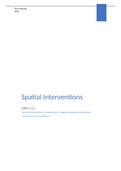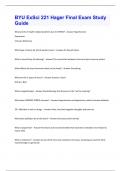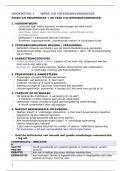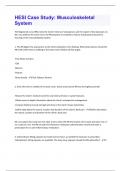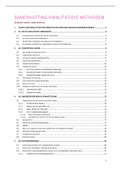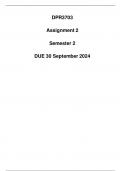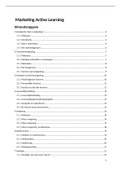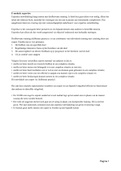2021
Spatial Interventions
TOPIC 1 & 2
SOCIALE GEOGRAFIE & PLANOLOGIE / URBAN & REGIONAL PLANNING
UNIVERSITY OF AMSTERDAM
,Fleur Hessing - 2021
Index
Topic 1: A Rational View of Planning......................................................................................................3
Lecture 1: A Relational View of Planning (including the historical transition of law and society in
bird view)............................................................................................................................................3
Salet, W (2014): The Authenticity of Spatial Planning Knowledge..................................................3
Nonet, Ph.; Selznick, Ph. (1978): Three types of law.......................................................................5
Kagan, RA (2001): On “Responsive Law”........................................................................................6
Lecture 1: A relational view of planning (08/09/2021)...................................................................8
Lecture 2: Pragmatism......................................................................................................................10
James, W (1907): What Pragmatism means.................................................................................10
Hoch, C (2016): Utopia, Scenario and Plan: A pragmatic intergration..........................................12
Salet, W. (2018) ‘Legitimacy in Action: The Logic of Pragmatism and Institutional Legality’. First
Part of Chapter 3..........................................................................................................................14
Lecture 2: The Roots of Pragmatism (10/09/2021).......................................................................15
Workshop Task 1 - Defining problems and their contradictions.......................................................18
Friend, J.K. (1977): The dynamics of policy change.......................................................................18
Campbell, S. (2003). Green cities, growing cities, just cities? Urban planning and the
contradictions of sustainable development..................................................................................20
Lecture 3: Hayek...............................................................................................................................22
Hayek, F (1973): Cosmos and Taxis...............................................................................................22
Moroni, S (2010): Rethinking the theory and practice of land-use regulation: Towards nomocracy
......................................................................................................................................................24
Rijswick, M. van, W. Salet (2012) ‘Enabling the contextualization of legal rules in responsive
strategies to climate change’........................................................................................................26
Lecture 3: Friedrich A. Hayek........................................................................................................28
Workshop Task 2 - Dissecting the regulatory and power conditions of interventions......................31
Hobma & Jong (2016): Ch4. Statutory Spatial Plans.....................................................................31
Topic 2: How institutions may make a difference in pragmatic practices of planning..........................35
Lecture 4: Institutions and planning.................................................................................................35
Salet, W. (2018) ‘Institutions in Action’........................................................................................38
Salet, W (2018): Public Norms and Aspirations............................................................................40
Lecture 4: A co-evolution of pragmatism and institutions in action.............................................42
Lecture 5: Planning and Law.............................................................................................................46
Fuller, L.L. (1969) ‘The morality that makes law possible’............................................................46
Salet, W. (2018) ‘Legitimacy in Action: The Logic of Pragmatism and Institutional Legality’ – 2...48
Lecture 5: The normative meaning of law and its implications for planning................................50
1
,Fleur Hessing - 2021
Workshop Task 3 - Understanding the discursive politics of spatial interventions...........................55
Sandercock, L. (2003). Out of the Closet: The Importance of Stories and Storytelling in Planning
Practice.........................................................................................................................................55
Lecture 6 - Political Institutions - Substantive Norms and Norms of Political Ordinance..................58
Savani, F. (2020) The circular economy of waste: recovery, incineration and urban reuse..........58
Salet, W. (2021) ‘Public Norms in Practices of Transitional Planning—The Case of Energy
Transition in The Netherlands’.....................................................................................................62
Lecture 6: Political Norms in the Case of Energy Transition..........................................................64
2
, Fleur Hessing - 2021
Topic 1: A Rational View of Planning
Lecture 1: A Relational View of Planning (including the historical
transition of law and society in bird view)
Salet, W (2014): The Authenticity of Spatial Planning Knowledge
Spatial planning was initiated by civic organizations rather than by governmental intervention
Spatial planning studies: seek to improve collective action as a form of spatial intervention in
legitimate and effective ways
* Characteristic feature: relation between theory and practice
- context-bound, normative aim of a better future, knowledge and action towards a new stage
Scientific researchers: investigate the normative practice but DO NOT intervene
a critical distance from planning authorities and other participants
*Planning studies are highly interwoven with societal networks in order to investigate practices
- Researchers keep separate roles but often employ in networks
Social practices: extremely ambiguous and complex
uncertainty of knowledge about the object of intervention an about the impact
*Social reality: hard to grasp for planners in practice, requires modesty from scientists
Insights of spatial planning theory: result of investigating actual experiences
Social evolution is not devoid of powerful social structures; the interventions have to be
responsive to social driving forces in order to make a difference
Planning is a normative engagement to achieve a better spatial future. It deals with values
and with social and political objectives, which differ in various backgrounds and rationalities,
and with issues of social and spatial transformation
Spatial planning interventions often take unexpected trajectories and display unexpected
implications. This requires intelligent strategies to deal with imperfectness and complexity
Spatial planners have become aware of the multi-faced nature of knowledge
Planners have learned to deal with planning processes as dedicated but open-minded and
open-ended processes
*The emerge of theoretical concepts: interaction
between science and action
The authentic scientific object of spatial planning
studies has five dimensions
* They have many overlaps with the science
object of other disciplines: interdisciplinary
3


